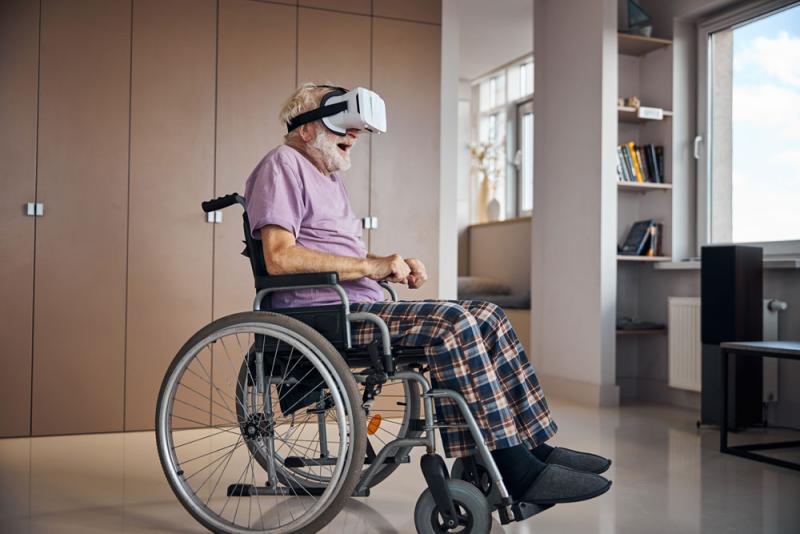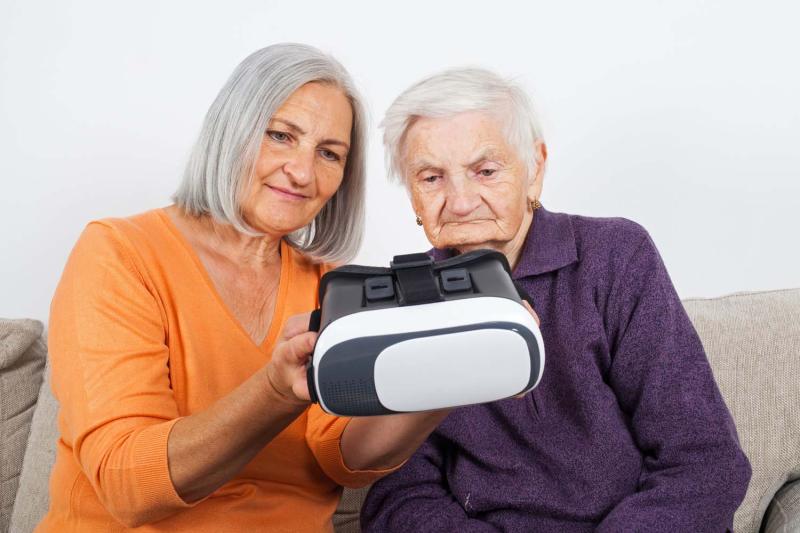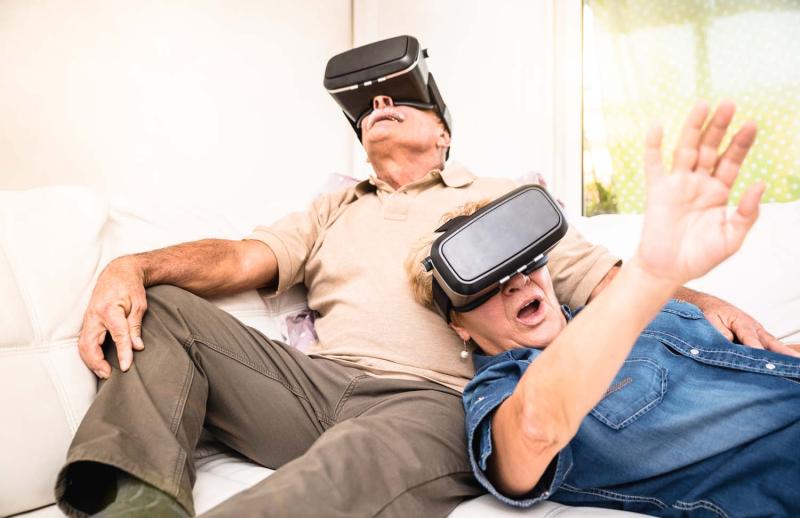Key points
- Virtual reality (VR) involves a computer software system that generates simulations of 3D environments that a person can interact with using their own movements.
- All studies included in our scoping review were conducted in residential aged care.
- Many older people reported that they enjoyed engaging with VR.
- Older people considered interaction with VR may be helpful to distract them from ongoing pain.
- Interest in VR was higher when the content was personally relevant to the individual.
Virtual reality (VR) involves a computer software system that generates simulations of real or imagined 3D environments that a person can interact with using their own movements. [1] VR usually involves the user wearing a headset and holding handheld sensors or wearing gloves to interact with their surroundings. VR has advantages in the field of health promotion in aged care and is often used to increase engagement and motivation for older adults. VR may involve interactive games, exercise, or relaxation environments such as a simulated garden. [2]
VR technologies can be used for a range of activities in aged care including pain management. VR can potentially engage an individual to distract them from pain by guiding them through relaxation exercises, VR games, or calming scenery. [2] VR can also be used to support reminiscence therapy by recreating historical events, settings, and even personal memories. [3]
This evidence theme summarises one of the key issues we identified as part of a scoping review of research on human factors and technology in aged care. We identified five studies on this topic. [4-8] All studies were conducted in residential aged care. If you need more information on this topic, try using the PubMed searches below.
The studies we included in our scoping review reported on the perceptions and attitudes toward VR from both older adults and staff working in aged care. These studies found that:
- Most people reported that they enjoyed (or were observed to seemingly enjoy) the experience of engaging in VR. [4, 5, 8]
- Participants reported several reasons for discomfort, notably the elastics used to secure the head-mounted device on the head, poor image focus, and difficulty accommodating glasses under the head-mounted device. [5]
- Interest in VR was higher when the content was personally relevant to the individual. [5]
- Participants enjoyed participating in immersive VR experiences that could be tailored to their interests. Some participants stated that the personalisation that VR offered was an advantage over the usual activities offered in the facility. [8]
- Participants expressed excitement about sharing their experiences of VR with family. [8]
- The experience of using the VR hardware for exercise was generally positive but could still be challenging for participants. [6]
- There were some reported issues related to calibration, buttons, and locating the controllers in the physical environment after putting the headset on. [6]
- Some participants, especially those using VR for the first time, mentioned that they needed to ask for technological support at times while playing (e.g., for help to launch or exit the game). [6]
- Most people seemed to prefer scenery that was somewhat familiar to them (e.g., the great barrier reef or farmyard footage rather than international destinations). [4, 7]
- Whether people had dementia or not, did not seem to make a difference to adverse reactions to VR. [4]
- People with and without dementia perceived that the VR experience may help to distract them from ongoing pain. [7]
- The act of moving forward/backward and turning appeared to be relatively instinctual for people living with dementia. [6]
- Some individuals reported some issues when using VR, including worrying that they may forget how to use the hand controls, that the head-mounted device was uncomfortable at times, and the arms of wheelchairs could get in the way of them interacting with the virtual environment. [8]
- Keep in mind that some individuals will prefer to engage in a group setting, and others may feel more comfortable in a private space without others around [4]
- Tailor VR experiences to the individual. While some people may enjoy experiencing novelty (e.g., a tour of a landmark in a foreign country), some may prefer VR experiences that are somewhat familiar (e.g., the beach or google street view of an old home). [4, 5]
- Consider any movement limitations an individual may have when introducing them to a technology. [6, 8]
- Consider allowing individuals to try the VR head mounted device before expecting or encouraging them to navigate/interact with their environment (e.g., using the controllers) [8]
- Samal L, Fu HN, Camara DS, Wang J, Bierman AS, Dorr DA. Health information technology to improve care for people with multiple chronic conditions. Health Serv Res. 2021;56(5):1006-1036.
- Levac D, Glegg SMN, Sveistrup H, Colquhoun H, Miller PA, Finestone H, et al. A knowledge translation intervention to enhance clinical application of a virtual reality system in stroke rehabilitation. BMC Health Serv Res. 2016;16(1):557.
- Li G, Li X, Chen L. Effects of virtual reality-based interventions on the physical and mental health of older residents in long-term care facilities: A systematic review. Int J Nurs Stud. 2022:104378.
- Brimelow RE, Dawe B, Dissanayaka N. Preliminary research: Virtual reality in residential aged care to reduce apathy and improve mood. Cyberpsychol Behav Soc Netw. 2020;23(3):165-170.
- Appel L, Appel E, Kisonas E, Lewis S, Sheng LQ. Virtual reality for veteran relaxation: Can VR therapy help veterans living with dementia who exhibit responsive behaviors? Front Virtual Real. 2022;2.
- Muñoz J, Mehrabi S, Li Y, Basharat A, Middleton LE, Cao S, et al. Immersive virtual reality exergames for persons living with dementia: User-centered design study as a multistakeholder team during the COVID-19 pandemic. JMIR Serious Games. 2022;10(1).
- Chaze F, Hayden L, Azevedo A, Kamath A, Bucko D, Kashlan Y, et al. Virtual reality and well-being in older adults: Results from a pilot implementation of virtual reality in long-term care. J Rehabil Assist Technol Eng. 2022;9:20556683211072384.
- Baker S, Waycott J, Robertson E, Carrasco R, Neves BB, Hampson R, et al. Evaluating the use of interactive virtual reality technology with older adults living in residential aged care. Inf Process Manag. 2020;57(3).
Connect to PubMed evidence
This PubMed topic search is focused on research conducted in aged care settings (i.e., home care and residential aged care). You can choose to view all citations or free full-text articles.


